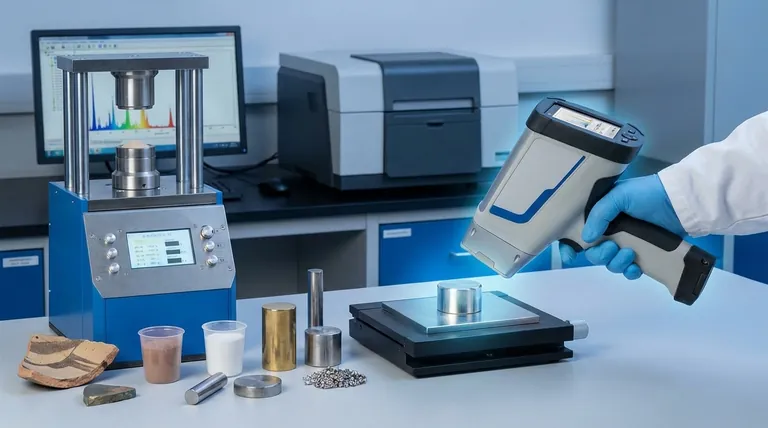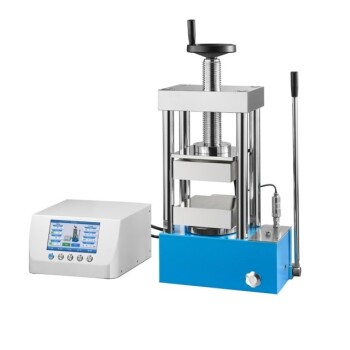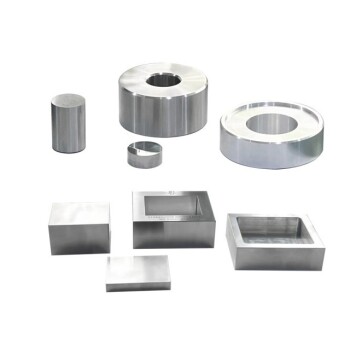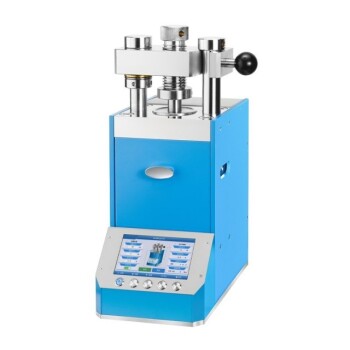At its core, X-ray Fluorescence (XRF) is a powerful and non-destructive analytical technique used to determine the precise elemental composition of a material. It works by bombarding a sample with a primary X-ray beam, which causes the atoms within the sample to emit secondary, "fluorescent" X-rays. A detector measures the energy of these secondary X-rays to identify exactly which elements are present.
The true value of XRF is not just its ability to identify elements, but its capacity to do so rapidly and without harming the sample. This makes it an indispensable tool for immediate quality control, material verification, and the analysis of irreplaceable objects.

How XRF Reveals a Material's "Atomic Fingerprint"
The XRF process is an elegant application of atomic physics that unfolds in three distinct steps. The entire process hinges on the principle that every element has a unique electronic structure.
Step 1: Excitation
The process begins when an XRF instrument directs a beam of high-energy X-rays onto the surface of the sample being tested. This primary beam is powerful enough to disrupt the atoms in the material.
This energy strikes an atom and knocks an electron out of one of its low-energy, inner orbital shells. This creates an unstable vacancy, like a missing piece in a puzzle.
Step 2: Fluorescence
To regain stability, an electron from a higher-energy, outer orbital shell immediately drops down to fill the vacancy. As this electron moves from a high-energy state to a low-energy state, it must release the excess energy.
This released energy is emitted from the atom as a secondary, fluorescent X-ray. The crucial point is that the energy of this emitted X-ray is uniquely characteristic of the element it came from. It is a distinct "atomic fingerprint."
Step 3: Detection and Analysis
A detector inside the XRF analyzer collects these emitted secondary X-rays and sorts them by their energy level.
The device then plots these energies into a spectrum, showing peaks at the specific energies corresponding to each element found in the sample. The intensity of each peak helps determine the element's concentration.
Understanding the Trade-offs and Limitations
While powerful, XRF is not the right tool for every analytical task. Understanding its limitations is critical for interpreting results correctly.
Surface-Level Information
A crucial limitation is that XRF is fundamentally a surface analysis technique. The primary X-rays only penetrate a few micrometers to a few millimeters into the material.
The results, therefore, represent the composition of the surface, which may not be the same as the bulk material, especially if the object is coated, plated, corroded, or contaminated.
Challenges with Light Elements
XRF systems are generally less sensitive to very light elements (e.g., those with an atomic number below ~13, like Sodium or Magnesium).
The characteristic X-rays emitted by these light elements have very low energy. This makes them easily absorbed by the air between the sample and the detector, or even by the detector window itself, making them difficult or impossible to measure with many standard instruments.
Quantitative vs. Qualitative Analysis
XRF is excellent for qualitative analysis (identifying which elements are present). However, achieving accurate quantitative analysis (determining the exact percentage of each element) requires careful calibration.
Accurate concentration measurements depend on using calibration standards that are very similar in physical form and composition (the "matrix") to the sample being tested.
Making the Right Choice for Your Application
Use these guidelines to determine if XRF is the appropriate method for your goal.
- If your primary focus is rapid quality control or material sorting: XRF is an unmatched tool for fast, on-the-spot verification in manufacturing, alloy identification, or scrap metal recycling.
- If your primary focus is analyzing precious or irreplaceable items: The non-destructive nature of XRF makes it the default choice for archaeology, art conservation, and museum science.
- If your primary focus is certifying bulk composition or analyzing for light elements: You may need to consider destructive, but more comprehensive, techniques like Inductively Coupled Plasma (ICP) or Combustion Analysis.
By understanding both its powerful capabilities and its distinct limitations, you can effectively leverage XRF as a precise and efficient analytical tool.
Summary Table:
| Aspect | Details |
|---|---|
| Technique | Non-destructive elemental analysis using X-rays |
| Key Steps | Excitation, Fluorescence, Detection and Analysis |
| Applications | Quality control, material sorting, archaeology, art conservation |
| Limitations | Surface-level analysis, challenges with light elements, requires calibration for quantification |
Unlock precise elemental analysis for your laboratory with KINTEK's advanced lab press machines! Whether you need automatic lab presses, isostatic presses, or heated lab presses for sample preparation in XRF and other techniques, our equipment ensures reliable, efficient results. Enhance your lab's capabilities and streamline your workflow—contact us today to discuss your specific needs and discover how we can support your success!
Visual Guide

Related Products
- Laboratory Hydraulic Press Lab Pellet Press Button Battery Press
- Laboratory Hydraulic Press 2T Lab Pellet Press for KBR FTIR
- 24T 30T 60T Heated Hydraulic Lab Press Machine with Hot Plates for Laboratory
- Heated Hydraulic Press Machine With Heated Plates For Vacuum Box Laboratory Hot Press
- Manual Laboratory Hydraulic Press Lab Pellet Press
People Also Ask
- How are geological samples prepared for XRF analysis? Ensure Accurate Results with Proper Pellet Prep
- What are the durability and efficiency benefits of hydraulic pellet presses? Boost Lab Productivity with Reliable Performance
- How are hydraulic presses used in spectroscopy and compositional determination? Enhance Accuracy in FTIR and XRF Analysis
- Why is the hydraulic portable press considered accessible for everyone in the lab? Unlock Effortless Force and Precision for All Users
- What are the advantages of using a hydraulic mini press? Achieve Precise Force in a Compact Lab Tool



















